Dickinson College Archives and Special Collections Department holds significant research material ranging from medieval times to the present, and while located at a small institution, it is home to a wide range of rare books, photographs, and other artifacts. Of these historical materials, Lydia Maria Child’s revolutionary cookbook entitled “The Frugal Housewife” stands out as especially loved. At first glance, the book is barely that – it is no longer bound and must be held together by a ribbon. As we take a closer look, the cookbook is more than it seems, and it holds more than the originally printed recipes and remedies.
In a conversation with Dickinson College Archivist Malinda Triller-Doran, she informed me that while the book’s journey to our archives is not explicitly known, we can guess that it was once a part of Charles Coleman Sellers’s Library and was donated to the Archives with the rest of his collection after his death in 1980 (Triller-Doran).
The full title of the book is “The Frugal Housewife: Dedicated to Those Who Are Not Ashamed of Economy.” The audience for this book is presumably the average, middle- or lower-class housewife in America. Most of the included recipes are simple and require minimal ingredients, and in addition to the normal recipes expected in a cookbook, a significant portion of the book is reserved for remedies and advice for topics outside of the kitchen, including laundry and cleaning tips.
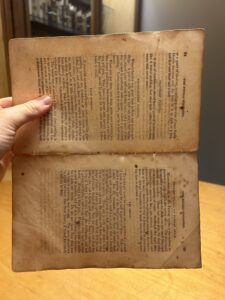
This specific edition is the fourth edition, and was published in Boston, Massachusetts in 1831 by Carter, Hendee, & Babcock. The size of the book (5in x 7.5in x 1 in) suggests its economy. A larger-sized book would not be affordable by the audience, and it is more convenient for storage and use at this moderate size. This cookbook is 118 pages, but pages 109 – 112 are missing. This mishap could be due to the poor state of the binding and the fact that most of the pages are no longer connected. The paper itself, while no longer bound together, is thick, with clean-cut edges, and, in comparison to the deteriorating state of the binding, has held up exceptionally well over time. While yellowed and stained on every page, none of the paper is torn or ripped, and only five pages have been bent at the top right corner. This folding looks accidental but could also have been a bookmark for the owner. The typeface is difficult to determine, as it looks like Times New Roman, or some other serif font. After running a picture through font identification software, I think the font is “Aquatic Rough (WhatFontIs.com).”
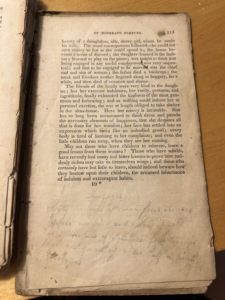
While the book was not printed with illustrations or pictures, a previous owner – presumably an “M. Cady” based on the repeated signatures across the front cover – marked up the book with drawings, signatures, additional recipes, and other inscriptions. The first page of the book was once a blank protective sheet but has since been lined and written on both sides with multiple recipes for frosting, cookies, cake, sausages, and steam pudding. In addition to this once-blank page, the blank spaces on pages 80, 103, and 113 are home to more personal recipes. While the print is messy and the pencil is mostly faded, from what I can tell the recipes are for “Pork Cake Loaves,” “Sausages,” and “Good Common Cake Loaves.”
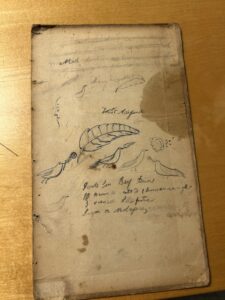
Although the front and middle of the cookbook housed mostly inscribed recipes, the back cover is covered in drawings of birds, fathers, flowers, and a face. There is a passage at the top that has since been crossed out, but from what I can tell is another recipe including ingredients like butter and buttermilk.
These recipes and the writing on the front cover were in the same handwriting and pencil as the “M. Cady” signature, and after further investigation, this woman is presumably Mary Cady (previously Mary Webb, married to Hiram Cady). Apart from the repeated “M. Cady” stamps and signatures, there is an additional signature that reads “Mrs. Hiram Cady.” After a deep internet search, I found a picture of a woman named Mary Webb who married a Mr. Hiram Cady, who passed away in 1876 (WikiTree). I cannot find much else on her other than her burial location in Washtenaw County, Michigan. There is one recipe on the back cover in a different, darker handwriting for a Beef dish. There are two more names inscribed but they are completely illegible.
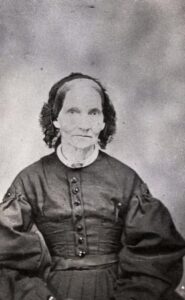
The front matter of the book includes the aforementioned, no-longer-blank page, a title page, a page containing two notes, and the introductory chapter. The title page is nearly identical to the cover of the book, including the full title (“The Frugal Housewife: Dedicated to Those Who Are Not Ashamed of Economy”), a dedication, two quotations – one by Benjamin Franklin and one with no source – the edition of the book, and publication information. 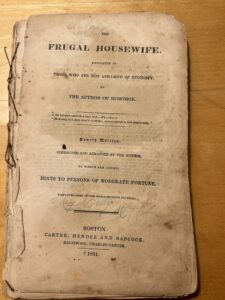
The page with notes contains one from Lydia Maria Child stating her reasoning and additions to this edition and one from the Clerk of the District of Massachusetts emphasizing its publication location. In place of a table of contents at the beginning of the book, there is instead an alphabetical index at the end, beginning with “Advice, General” and concluding with “Pastry.”
The organization of the book is clear and simple, and extremely easy to skip through. Since it holds recipes and remedies, a reader will use it for specific reasons and may need to skip around to find the entry they are looking for. The short paragraphs, clear titles, and alphabetical index make this a convenient manual for the average reader. Food groups include “Herbs,” “Meat Corner, or Salted, Hams &c,” “Puddings,” and more. Remedies include small healing tips, specifically for burns and cuts, in addition to more first-aid style tips. The author takes a familiar, conversational tone, using both first person and addressing the reader directly in certain passages.
The physical condition of the book emphasizes how loved this book was, proving its convenience and popularity. This is not a book that is held and flipped through. It is quick to lie flat, suggesting its long history of laying on a table or kitchen countertop. This book is similar to our modern-day “Cooking for Dummies,” with both easy, clear recipes and significant advice and remedies. Child goes above and beyond for her reader by delving deeper than the assumed recipes of a cookbook to include tips and tricks for chores and tasks outside of the kitchen. Despite this information on this cookbook, the catch-all guide to being an economical housewife holds more secrets – in both its typed content and added inscriptions – that I look forward to uncovering over the course of the semester.
Works Cited
Child, Lydia Maria. The Frugal Housewife : Dedicated to Those Who Are Not Ashamed of Economy. Fourth edition / corr. and arr. By the author, to Which are added, Hints to persons of moderate fortune., Carter, Hendee and Babcock, 1831.
“Find Any Font from Any Image.” Upload Image, www.whatfontis.com/?s3. Accessed 22 Sept. 2024.
“Mary (Webb) Cady.” WikiTree, 28 June 2023, www.wikitree.com/wiki/Webb-14437.
“Mrs. Hiram Cady (Mary Webb).” Ypsilanti Historical Society Photo Archives, quod.lib.umich.edu/y/yhsic1/x-08073/PHOTO08073?lasttype=boolean%3Blastview. Accessed 14 Oct. 2024.
Triller-Doran, Malinda. Personal interview with the author. 18 September 2024.
Leave a Reply